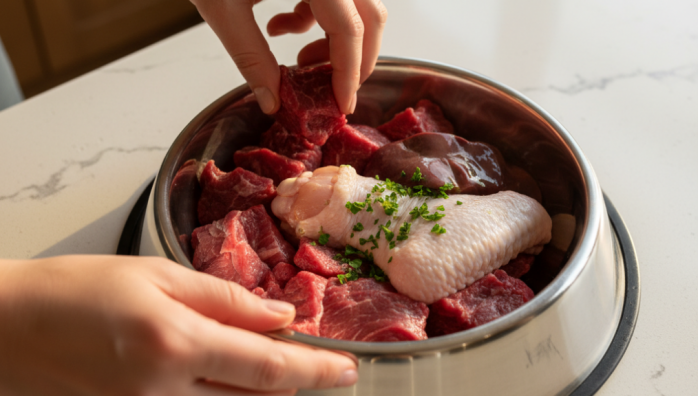Balancing Nutrients in Raw Pet Meals
by admin in Pet Care Basics 2 - Last Update November 14, 2025

When I first ventured into the world of raw feeding, my biggest fear wasn't handling raw meat—it was nutrient balancing. I spent countless nights staring at charts and percentages, completely overwhelmed. The idea that I could get it wrong and harm my beloved dog was terrifying. But over the years, I've learned that balancing a BARF (Biologically Appropriate Raw Food) diet is less about rigid math and more about understanding a few core principles. It's a journey, and I want to share what I've learned to make your start a little less daunting than mine was.
The 80/10/10 rule: a starting point, not the destination
You'll see the 80/10/10 rule everywhere when you start researching. It stands for 80% muscle meat, 10% raw edible bone, and 10% organ meat. In my experience, this is an excellent foundation. It provides a basic blueprint to ensure you're not just feeding a bowl of ground beef. However, I quickly realized it was a guideline. Some dogs, especially more active ones, might need slightly more muscle meat for energy, while others might need adjustments to the bone content to keep their digestion perfect. I started with 80/10/10 and watched my dog's energy levels, coat, and stools, tweaking slightly from there.
Why muscle meat isn't just 'meat'
My first mistake was thinking any muscle meat would do. But variety is the absolute key to a balanced profile of amino acids and fats. Don't just stick to lean chicken breast. I rotate between beef, turkey, lamb, and occasionally fish. I also make sure to include heart meat regularly, which, while technically a muscle, is incredibly rich in taurine—an essential nutrient for both dogs and cats.
Going beyond the basics: organs and healthy additions
The real nutrient density in a raw diet comes from the smaller components. This is where I truly saw a difference in my pet's vitality once I got the hang of it. It's the part that often worries beginners the most, but it's simpler than it seems.
Organ meats: the nutrient powerhouses
The 10% organ meat rule should ideally be split. About half of that (5% of the total meal) should be liver, which is a powerhouse of Vitamin A. The other 5% should be a mix of other secreting organs like kidney, spleen, or pancreas. A word of caution from my own messy experience: introduce organs slowly. They are incredibly rich, and too much too soon can lead to an upset stomach. I started with tiny slivers and gradually worked my way up.
The role of 'extras' like fur, fiber, and fish oil
A truly balanced diet, in my opinion, mimics whole prey. This means including things that provide fiber and unique nutrients. I sometimes add a small amount of puréed, pet-safe vegetables (like kale or pumpkin) for fiber and antioxidants. For essential omega-3 fatty acids, which are crucial for reducing inflammation and supporting coat health, I add a high-quality fish or krill oil to each meal. This simple addition made my dog's coat noticeably shinier within weeks.
My final thoughts and a gentle reminder
Creating balanced raw meals felt like a huge mountain to climb at first, but it's become a simple, rewarding routine. Start with the 80/10/10 guideline, focus on variety, and introduce new things slowly. Most importantly, observe your pet. They are the ultimate guide to what's working. And while I'm sharing what has worked wonders for my animals, I always recommend chatting with a holistic veterinarian or a certified pet nutritionist. They can help you tailor these principles perfectly for your pet's unique needs, giving you complete peace of mind.









